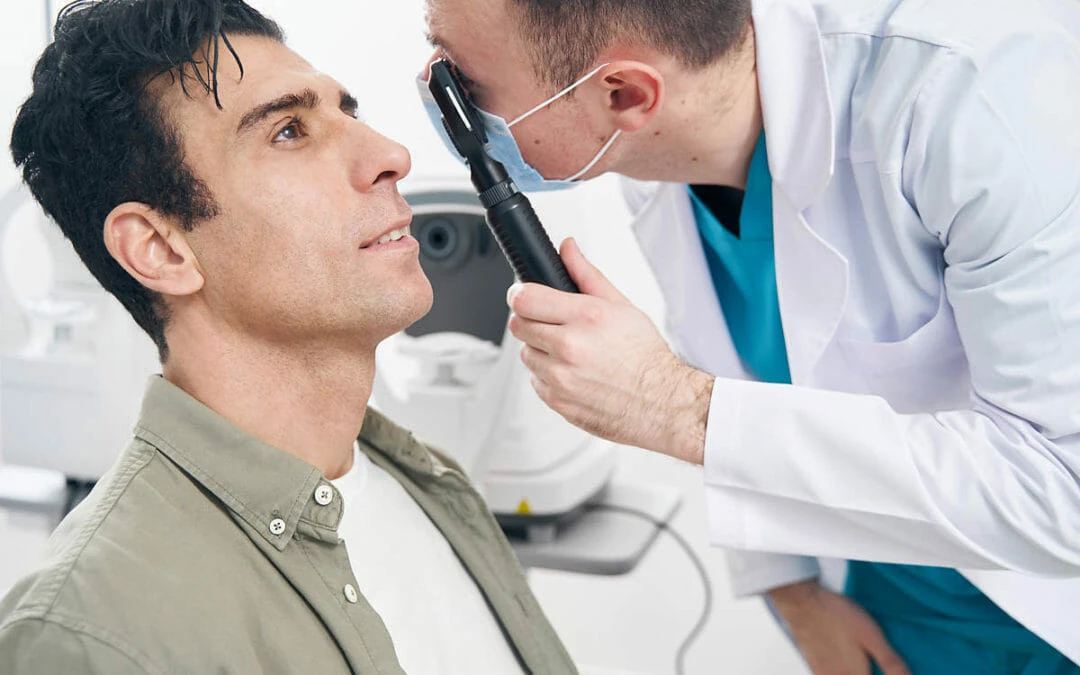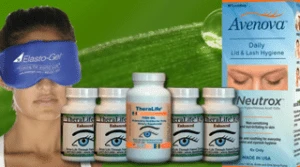A chalazion typically appears as a painless lump or swelling on your upper or lower eyelid. It is sometimes called an eyelid cyst or a meibomian cyst. A chalazion is a slowly developing lump that forms due to blockage and swelling of an oil gland in the eyelid. They don’t usually feel painful, they last less than two weeks.
The development of chalazion is triggered when the meibomian glands around eyelids become blocked. The gland produces oil for lubricating the eye.
Stop Chalazion with TheraLife
Prevent blocked oil glands that form a chalazion by treating the root cause – dry eyes.
Warm compress to aid chalazion recovery and prevent recurrence
How does it work?
- Theralife Eye Capsules to revive and restore normal tear function from inside out
- OMega 3 fish oil to reduce inflammation and provide lubrication to ease dry eyes
- Warm compress to treat chalazion and allow it to break open and drain.
- Eyelid cleanser to prevent eyelid infection and clear debri from oil glands to prevent clogging.
Customer Story
No more Chalazion
After a summer of many,large styes a few years ago, I was diagnosed w/ Blepharitis. I started to read about natural cures & found the Theralife site. I’ve been using the Enhanced Eye for a few years now & coupled with diligent lid cleansing, I have had only 2 styes in 2 years.. Dr Yang is so responsive & ready to help…. I happy to have found a natural way to deal w/ this condition to keep in check.
E S – United States
What is a chalazion?
A chalazion is a small bump in the eyelid caused by a blockage of a tiny oil gland.
It is inflammation on the eyelid due to blocking the eye cells.
It’s sometimes called chalazia.
It is more commonly found under the eyelid.
It will be easy to see through both eyes.
Chalazia sometimes leave and return.
Chalazion vs. Stye
The difference between a Chalazion and stye may be difficult because it may be caused by infection.
Stye
Styes are sometimes found near the edges of eyelid, often behind an eyelash, but Chalazia occur mostly near the center of the eyelid.
Styes have more potential for pain.
It has an orange tinge at the center, which can burst within days.
If there are no signs of infection, stye can turn into chalazion.
A stye produces a red, swollen, painful lump on the edge or the inside of the eyelid and usually occurs closer to the surface of the eyelid.
If left untreated, a stye can result in the formation of a chalazion.
Chalazion
If the chalazion does not go away after several weeks, it may require medical treatment, which may include an incision to drain or an injection of steroids to reduce the inflammation and swelling.
Is chalazion a stye?
Chazion is not a stye,
Styes are bacteria infections causing oil glands to become clogged.
Styes are painful.
Chalazia usually have little pain and appear on the eyelids more directly than the stye.
How long will I have it?
If properly handled, it can heal over a month.
Symptomatic healing may take up to six weeks.
What causes it?
Chalazia can arise when an obstruction of the eyelid is seen.
This gland keeps the eye moist.
The blocked gland retains oil and expands.
Eventually the fluid drains out.
Causes
Your body has glandular functions.
It is important for cellular organs to work properly in order to function properly.
Your upper and lower eyelids produce oils which combine with tears to moisturize and protect your eyes.
If the oil gets thicker or your gland is blocked from an infection, you will get chalazion.
Generally infections are rare, but can be deadly.
Chronic inflammation of the eyelid near the oil gland openings ( blepharitis ), predisposes to the development of a chalazion.
Persistent blepharitis may result in recurrent chalazia.
Blepharitis may be aggravated by poor eyelid hygiene that includes eye rubbing in children.
Certain skin types, such as rosacea may be more prone to chalazia.
Meibomian glands
These are small glands lining the edge of the eyelids produce oil that helps to lubricate the surface of the eye.
When one of these glands becomes blocked, oil backs up inside the gland and forms a bump in the eyelid.
Break down of the oily secretions causes inflammatory cells to rush to the area.
This irritates the surrounding eyelid skin causing it to become red and swollen and sometimes painful.
Causes & risk factors
- Acne rosacea.
- Chronic blepharitis (inflammation of the eyelids, often from excess bacteria).
- seborrheic dermatitis
- Tuberculosis.
- Viral infection.
Rarely chalazions may be an indication of an infection or skin cancer.
Symptoms
Chalazions start with a small area that is red, swollen, or sore.
After several days, the pain disappears and the lump is still noticeable.
Chalazia are painless bump or lump in the upper eyelid or, less frequently, in the lower eyelid.
Caused by a thickening of the fluid in the oil (meibomian) glands of the eyelid.
Tearing and mild irritation may result as the obstructed glands are needed for healthy tears.
You can get blurred vision, if the chalazion is large enough to press against the eyeball.
Diagnosis
Chalazia are usually diagnosed by an eye doctor, who may advise the best treatments available.
It is not necessary to undergo a specific treatment.
External examination of the eye, including lid structure, skin texture and eyelash appearance.
Evaluation of the lid margins, base of the eyelashes and oil gland openings using bright light and magnification.
Your eye doctor is likely to ask for information about your symptoms, your eye issues, or your overall health problems.
Whenever you have a chalazion, you can consult a specialist eye specialist.
They’re going to want to exclude other eye issues.
These health professionals may assess the problem and give treatment options.
Rarely, sebaceous cell carcinoma can masquerade as recurring chalazia.
External examination of the eye, including lid structure, skin texture and eyelash appearance.
Evaluation of the lid margins, base of the eyelashes and oil gland openings using bright light and magnification.
How do you treat it?
See your doctor if you think you have a chalazion. They may want to check it and tell you how to take care of it to help it heal.
They can also suggest certain eye drops or creams to use.
Typically, treatment is done at home.
Most Chalazia disappears within a month.
If the symptoms persist, you need to seek the advice of a medical professional.
Chalazions are usually drained by tiny incisions to drain.
In addition, steroid injection may be required.
Treating conditions like blepharitis and meibomian gland dysfunction can keep chalazia from coming back.
Can it be prevented?
You can prevent it by maintaining good cleanliness.
If your doctor does recommend treatment, options may include either home care or medical treatment.
Most chalazia resolve by themselves within several days to weeks, but sometimes they persist for months.
Home treatment
One remedy is to apply warm, moist heat to the area with a clean washcloth or a gel hot compress.
Your doctor or nurse can give you instructions about how often to do it and for how long.
warm compresses
Warm compresses over the affected area can promote drainage of the blocked gland.
Create a warm compress by dipping a clean, soft cloth in warm water and then wringing it out. Remoisten the cloth frequently to keep it wet and warm
Since they are not caused by an infection, antibiotic drops are not usually helpful.
Anti-inflammatory eye drops, ointments or an injection of steroid into the bump may be helpful.
If you have a chalazion that doesn’t go away with home treatment, see an eye specialist.
Oral antibiotics may be indicated if the chalazion is associated with bacterial infection of the surrounding eyelid tissues ( cellulitis ).
Do not wear eye makeup or contact lenses while you have a stye or chalazion.
Gently massage
Gently massage the eyelid a few times a day. Massage for a few minutes each day, using light to medium pressure. Gentle massage can help open the blocked oil gland
Can chalazion be prevented?
You can prevent chalazia by maintaining good cleanliness.
You can lower your odds of getting them by keeping your eyelids clean:
Wash your hands often, especially before touching contact lenses.
Wash face at bedtime to remove dirt and makeup.
Remove eye makeup before going to bed and replace mascara, eyeliner and eye shadow every 3 months.
Replace your eye makeup every 2 or 3 months. Don’t share makeup with anyone else.
Frequently Asked Questions
What happens if a chalazion is left untreated?
Chalazion left untreated can turn into a stye which is infectious. Then the treatment must include anti-biotics. Chalazion can also become hardened which require surgery for removal. Chronic chalazia can lead to eyelid deformaty, eyelashes growing inward causing pain.
What triggers chalazion?
Key factors that trigger chalazion include blepharitis ( inflammation of the eyelids caused by chronic dry eye), acne rosacea, dermatitis, or viral infections.
How serious is a chalazion?
Chalazion is typically not serious. However left untreated, chalazion can be recurrent and chronic. Some people have chalazion frequently which can cause a great deal of distress and discomfort.
How long did it take for your chalazion to go away?
With the use of warm compresses, antibiotics and gentle massage. A chalazion can go away in about 2 weeks. Consult your eye doctor to get the proper diagnosis and treatment plan. Consult with TheraLife for the all natural effective way of stopping chalazion and find a cure.
Conclusion
Chalazion is the most common form of focal swelling of the eyelid. Chalazia (the plural form of chalazion) are characterized by firm, painless, eyelid nodules that can occur on the upper or lower eyelid.
However chalazion can become chronic due to chronic dry eyes, and can require surgery if it hardens. Use TheraLife Eye Protocol ( see above) to treat dry eyes and prevent chalazion recurrence. Find your chalazion cure here.





